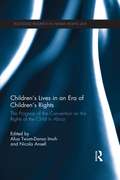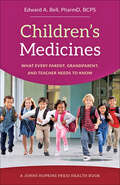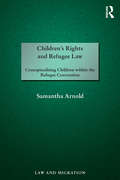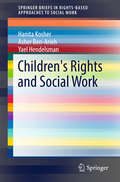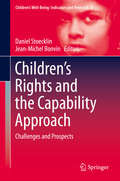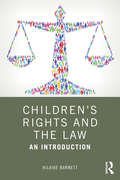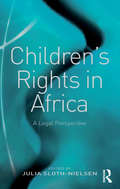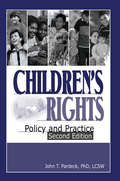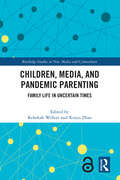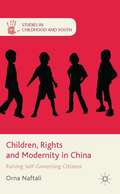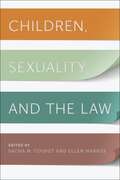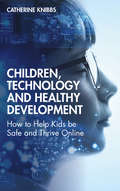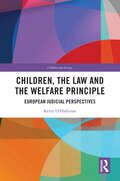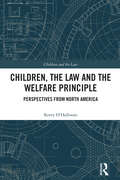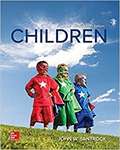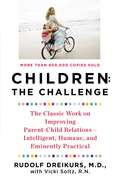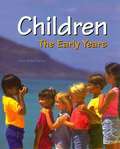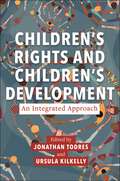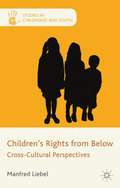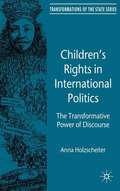- Table View
- List View
Children's Lives in an Era of Children's Rights: The Progress of the Convention on the Rights of the Child in Africa (Routledge Research in Human Rights Law)
by Nicola Ansell Afua Twum-Danso ImohThe Convention on the Rights of the Child (CRC), which was adopted unanimously by the United Nations General Assembly in 1989, marked a turning point in the perception of children in international law and policy. Although it was hoped that the Convention would have a significant and positive impact on the lives of all children, this has not happened in many parts of the world. This edited volume, based on empirical research and Non-Governmental Organisation project data, explores the progress of the Convention on the Rights of the Child, and to a lesser extent, the African Charter on the Rights and Welfare of the Child, in nine African countries in the 25 years since it was adopted by the UN General Assembly. The book considers the implementation of the Convention both in terms of policy and practice, and its impact on the lived experiences of children in societies across the continent, focusing on specific themes such as HIV/AIDS, education and disability, child labour, witchcraft stigmatisation, street children, parent-child relationships and child participation. The book breaks new ground in blending legal and social perspectives of the experiences of children, and identifies concrete ways forward for the better implementation of the CRC treaty in the various political contexts that exist in Africa.
Children's Medicines: What Every Parent, Grandparent, and Teacher Needs to Know (A Johns Hopkins Press Health Book)
by Edward A. BellAn indispensable guide to children’s medications that belongs on the bookshelf of every parent, grandparent, and teacher.Most parents have worried about the side effects and possible long-term consequences of administering a particular medication to their child. The medication may be available over-the-counter, like cough syrup, or it may be prescribed by a doctor, like an antibiotic. Parents want to know: Is the medication safe? Is it effective? Will it help my child? A pediatric pharmacist for nearly thirty years, Edward A. Bell has spent his career listening carefully to parents' concerns. In Children's Medicines, Bell draws on the latest scientific information, coupled with his experience in hospital and clinic settings, as a university professor, and as a parent, to answer questions about whether, when, and what medications to give to infants, children, and teenagers. Bell touches on practical issues of medication administration and explores areas of particular concern for parents.Inside the book, readers will find• information to help parents weigh the benefits and risks of medicines • an explanation of why some adult medications are not safe for children • descriptions of medicine for treating fever and common illnesses• practical tips on measuring, flavoring, and administering medicines• directions for giving medicine in the mouth, the nose, the ear, and the eye • advice for keeping children of any age safe around medications • facts about vaccinations: how they work, which ones are recommended, and their safety • a guide to the FDA's approval process for use of medicines by children• information about drug pricing, expiration dates, and storing medicine at home• a chapter on ADHD and the treatment of adolescent depression that takes into account the long-term side effects of antidepressants• details about the use of herbal and complementary therapies, including probiotics and vitamins • a discussion of over-the-counter cough/cold products• information on which websites to use for accurate medical and drug informationFull of information helpful to parents, grandparents, and others who provide care for children, Children's Medicines is a reliable and insightful guide to how drugs for children of all ages are prescribed and used.
Children's Rights and Refugee Law: Conceptualising Children within the Refugee Convention (Law and Migration)
by Samantha ArnoldChildren make up half of the world’s refugees and over 40 per cent of the world’s asylum seekers. However, children are largely invisible in historical and contemporary refugee law. Furthermore, there has been very limited interaction between the burgeoning children’s rights framework, in particular the Convention on the Rights of the Child (CRC), and the 1951 Convention relating to the Status of Refugees (Refugee Convention). This book explores the possibility of a children’s rights approach to the interpretation of the Refugee Convention and within that what such an approach might look like. In order to construct a children’s rights approach, the conceptualisations of children outside the legal discipline, within international children’s rights law and then within refugee law and refugee discourse are analysed. The approach taken is socio-legal and comparative in nature and the suitability of the Refugee Convention as a framework for the interpretation of child claims is examined. The book analyses to what extent the Refugee Convention is capable of dealing with claims from children based on the modern conceptualisation of children, which is underscored by two competing ideologies: the child as a vulnerable object in law to be protected and the child as subject with rights and the capacity to exercise their agency. The influence each regime has had on the other is also analysed. The work discusses how a children’s rights approach might improve outcomes for child applicants. The book makes an original contribution to child refugee discourse and as such will be an invaluable resource for academics, researchers and policymakers working in the areas of migration and asylum law, children’s rights and international human rights law.
Children's Rights and Social Work (SpringerBriefs in Rights-Based Approaches to Social Work)
by Asher Ben-Arieh Hanita Kosher Yael HendelsmanThis book provides a conceptual framework for children's rights as well as specific strategies and opportunities for social workers to apply in their work. It guides social work professionals and students through the history of children's rights. It also includes a call for a paradigm shift from a focus on the right to nurturance to the right to self-determination, as well as a contrasting look at children's rights in the West versus the rest of the world.
Children's Rights and the Capability Approach: Challenges and Prospects (Children’s Well-Being: Indicators and Research #8)
by Daniel Stoecklin Jean-Michel BonvinThis volume addresses the conditions allowing the transformation of specific children's rights into capabilities in settings as different as children's parliaments, organized leisure activities, contexts of vulnerability, children in care. It addresses theoretical questions linked to children's agency and reflexivity, education, the life cycle perspective, child participation, evolving capabilities and citizenship. The volume highlights important issues that have to be taken into account for the implementation of human rights and the development of peoples' capabilities. The focus on children's capabilities along a rights-based approach is an inspiring perspective that researchers and practitioners in the field of human rights would like to deepen.
Children's Rights and the Law: An Introduction
by Hilaire BarnettThis book identifies the definition of a child within the law, the rights of children, and discusses the extent to which primarily English law gives adequate recognition to and protection of these rights. To what extent does English law gives adequate recognition to and protection of the rights of children? Historically the idea of and protection of rights has focused on parental rights rather than the rights of the child. The rights of children have remained far less recognised and certain until recently. Using case studies from the United Kingdom and beyond, this book takes a thematic approach to children’s rights and considers topics including: underlying concepts such as the welfare of the child and safeguarding, the right to education and to medical treatment, the right to freedom from abuse and/or sexual and commercial exploitation, including contemporary challenges from forced marriage, FGM, modern slavery and trafficking, the role of the State in relation to children in need of care and protection, children's rights in the criminal justice system, the right to contract and employment. In addition, the book provides an introduction to key aspects of domestic and international law, including the Children Act 1989, the UN Convention on the Rights of the Child, the European Convention on Human Rights and the Human Rights Act 1998. The book will be of great interest to law and social science students in the areas of Child Development and Protection, Human Rights Law, Family Law, Child Law, and Child Studies, as well as to social workers, police officers, magistrates, probation officers and other related professions.
Children's Rights in Africa: A Legal Perspective
by Julia Sloth-NielsenThis collection is anchored in an African conception of children's rights and the law, and reflects contemporary discourses taking place in the region of the children's rights sphere. The majority of contributors are African and adopt an individual approach to their topic which reflects their first-hand experience. The book focuses on child rights issues which have particular resonance on the continent and the chapters span themes which are both broad and narrow, containing subject matter which is both theoretical and illuminated by practice. The book profiles recent developments and experiences in furthering children's legal rights in the African context, and distils from these future trends the specific role that the law can play in the African children's rights environment.
Children's Rights in the United States: In Search of a National Policy
by Lawrence S. Wrightsman Nancy E. Walker Catherine M. BrooksThe authors of this volume provide discussion on vital issues related to the rights of children in the United States, including: the historical and contextual perspective on the rights of children; the United Nations Convention on the Rights of the Child; the differing views on children's rights and competencies; and the rights of children within the family, the social service system, the health care system, the educational system, the juvenile justice system and in employment.
Children's Rights: A Comparative Perspective (Children's Human Rights Ser. #48)
by Ursula KilkellyThe articles in this volume shed light on some of the major tensions in the field of children‘s rights (such as the ways in which children‘s best interests and respect for their autonomy can be reconciled), challenges (such as how the CRC can be made a reality in the lives of children in the face of ignorance, apathy or outright opposition) and critiques (whether children‘s rights are a Western imposition or a successful global consensus). Along the way, the writing covers a myriad of issues, encompassing the opposition to the CRC in the US; gay parenting: Dr Seuss‘s take on children‘s autonomy; the voice of neonates on their health care; the role of NGO in supporting child labourers in India, and young people in detention and more.
Children's Rights: Policy and Practice, Second Edition
by Jean A. PardeckGet up-to-date information on children&’s and parent&’s rightsChildren have a basic human right to be free of abuse and maltreatment. The late Dr. John Pardeck&’s Children&’s Rights: Policy and Practice, Second Edition comprehensively explores the latest legal, psychological, sociological, policy, and child advocacy issues dealing with children&’s rights. Essential issues are clearly discussed involving children at home, in school, in foster care, and in residential facilities. This new edition of The Haworth Social Work Practice Press classic examines the practical and ethical issues inherent in balancing a child&’s right to self-determination against the same child&’s need to be protected.Children&’s Rights: Policy and Practice, Second Edition delves deep into the causes of abuse and neglect and offers help for families at risk. Techniques are presented for case and cause advocacy, as well as venues for family and individual therapy. Other discussions address the role and function of child protective services and the juvenile justice system, a review of effective social policy to protect and care for children, family health and children&’s rights issues, and children&’s rights in schools and day care facilities. This essential exploration includes extensive references and notes, a list of Web sites, and a comprehensive glossary of influential legal rulings focusing on children&’s rights.Children&’s Rights: Policy and Practice, Second Edition includes over 100 pages of new and updated material on: new rulings of the Americans with Disabilities Act (ADA) that have implications for children&’s rights legal case studies an overview and analysis of the Leave No Child Behind Act children&’s rights and school violence an expanded discussion on practice interventions focusing on various approaches for helping children adjust to substitute care an expanded examination on advocacy and children&’s rights, with emphasis on legal case studies as a tool for enhancing the rights of childrenBalancing theoretical considerations, solid information, and practical advice, Children&’s Rights: Policy and Practice, Second Edition is an essential resource for child welfare workers, attorneys, educators, students, parents, and social workers.
Children, Human Rights and Temporary Labour Migration: Protecting the Child-Parent Relationship (Routledge Research in Asylum, Migration and Refugee Law)
by Rasika Ramburuth JayasuriyaThis book focuses on the neglected yet critical issue of how the global migration of millions of parents as low-waged migrant workers impacts the rights of their children under international human rights law. The work provides a systematic analysis and critique of how the restrictive features of policies governing temporary labour migration interfere with provisions of the Convention on the Rights of the Child that protect the child-parent relationship and parental role in children’s lives. Combining social and legal research, it identifies both potential harms to children’s well-being caused by prolonged child-parent separation and State duties to protect this relationship, which is deliberately disrupted by temporary labour migration policies. The book boldly argues that States benefitting from the labour of migrant workers share responsibility under international human rights law to mitigate harms to the children of these workers, including by supporting effective measures to maintain transnational child-parent relationships. It identifies measures to incorporate children’s best interests into temporary labour migration policies, offering ways to reduce interferences with children’s family rights. This book fills a gap that emerges at the intersection of child rights studies, migration research and existing literature on the purported nexus between labour migration and international development. It will be a valuable resource for academics, researchers and policymakers working in these areas.
Children, Media, and Pandemic Parenting: Family Life in Uncertain Times (Routledge Studies in New Media and Cyberculture)
by Rebekah Willett Xinyu ZhaoThis book examines changes in families’ rules and routines connected with media during the pandemic and shifts in parents’ understanding of children’s media use.Drawing on interviews with 130 parents at the height of the COVID-19 pandemic, the book explores specific cultural contexts across seven countries: Australia, Canada, China, Colombia, South Korea, United Kingdom, and United States. Readers will gain an understanding of family media practices during the pandemic and how they were influenced by contextual factors such as the pandemic restrictions, family relationships and situations, socioeconomic statuses, cultural norms and values, and sociotechnical visions, among others. Further, encounter with theoretical framings will provide innovative ways to understand what it means for children, parents, and families to live in the digital age.This timely volume will offer key insights to researchers and graduate students studying in a variety of disciplines, including media and cultural studies, communication arts, education, childhood studies, and family studies.The Open Access version of this book, available at www.taylorfrancis.com, has been made available under a Creative Commons Attribution- Non Commercial- No Derivatives (CC- BY- NC- ND) 4.0 license.
Children, Rights and Modernity in China
by Orna NaftaliThis book is an original, ethnographic study of the emergence of a new type of thinking about children and their rights in urban China. It brings together evidence from a variety of Chinese government, academic, pedagogic and media publications, and from interviews and participant observations conducted in schools and homes in Shanghai, China.
Children, Sexuality, and the Law (Families, Law, and Society #1)
by Ellen Marrus Sacha M. CoupetAmerican political and legal culture is uncomfortable with children's sexuality. While aware that sexual expression is a necessary part of human development, law rarely contemplates the complex ways in which it interacts with children and sexuality. Just as the law circumscribes children to a narrow range of roles--either as entirely sexless beings or victims or objects of harmful adult sexual conduct--so too does society tend to discount the notion of children as agents in the domain of sex and sexuality. Where a small body of rights related to sex has been carved out, the central question has been the degree to which children resemble adults, not necessarily whether minors themselves possess distinct and recognized rights related to sex, sexual expression, and sexuality. Children, Sexuality, and the Law reflects on some of the unique challenges that accompany children in the broader context of sex, exploring from diverse perspectives the ways in which children emerge in sexually related dimensions of law and contemporary life. It explores a broad range of issues, from the psychology of children as sexual beings to the legal treatment of adolescent consent. This work also explores whether and when children have a right to expression as understood within the First Amendment. The first volume of its kind, Children, Sexuality, and the Law goes beyond the traditional discourse of children as victims of adult sexual deviance by highlighting children as agents and rights holders in the realm of sex, sexuality, and sexual orientation.
Children, Technology and Healthy Development: How to help kids be safe and thrive online
by Catherine KnibbsHow can adults keep children safe and healthy online now and in the future? How can we thrive alongside technology? This highly accessible book unpacks the latest psychological research, attachment theory and neurobiology to offer parents and professionals insight into how technology impacts children’s development, and how to navigate our lives online. Cath Knibbs shares her extensive experience to reveal what we know about human behaviour in cyberspace, and particularly that of children using devices, consoles and social media platforms. She offers deeper understanding of how and why children engage online and shows parents and professionals how, rather than being overwhelmed by the dangers and pathologies of cyberspace, we can learn to support children in using technology healthily. She covers key topics including social media use and abuse, impact of screen time, issues around gaming, and extreme behaviours online. By the end of this book you will be able to understand your child better, and have an understanding of what is happening in their minds, brains and bodies in relation to the technological and digital world. Children, Technology and Healthy Development is for all parents, and professionals in psychology, education, social care and the police who are concerned with understanding how we support children in an online world. It will also be valuable reading for those in tech design interested in the impact of technology on the developing human.
Children, the Law and the Welfare Principle: European Judicial Perspectives (Children and the Law)
by Kerry O'HalloranThis book continues the themes addressed by its five predecessors in this series by examining the role of the principle of the welfare interests of the child as addressed in international legislation and by international courts.It provides a record of the key cases in the development of the principle as articulated primarily by the European Court of Human Rights (ECtHR) and complemented by rulings of the Court of Justice of the European Union (CJEU), and the United Nations Committee on the Rights of the Child (UN CRC). It identifies and assesses themes arising from the many decades of ECtHR cases dealing with issues affecting the welfare interests and rights of children as referred to the Court from the 46 Member States that comprise the Council of Europe. By differentiating between the functions of the welfare principle and those of children’s rights – in the public (care, protection, and control), in the private (matrimonial, adoption, etc.), and in the hybrid (adoption from state care, etc.) sectors of family law – it reveals how the law relating to children is changing across Europe. By examining the international framework of legislation and related caselaw it identifies and assesses the themes in that law as they have unfolded over time.In addition to a digest of international cases and legislation – that identifies and tracks the role of the welfare principle and the emerging rights of children – lawyers, academics, and other researchers will find a wealth of information on how the law has evolved to reflect corresponding changes in social mores. For those interested in politics and social policy, there is much illuminating evidence on how the law has balanced this principle relative to others – such as proportionality and subsidiarity – within both civil and criminal contexts.
Children, the Law and the Welfare Principle: Perspectives from North America (Children and the Law)
by Kerry O'HalloranThis book continues the themes addressed by its two predecessors in this mini-series by examining the role of the principle of the welfare interests of the child in the law of the U.S. and Canada. It provides a record of the key milestones in its development in each country and conducts a comparative analysis of the contemporary law relating to children in both. In doing so, it focuses also on the Indigenous communities – the AN/AI and the First Nations – of the U.S. and Canada respectively. By identifying and analysing the functions of the principle in the public (care, protection and control, etc), private (matrimonial, adoption, etc) and hybrid (adoption from care, surrogacy, etc) sectors of family law, it builds a picture of the law relating to children in the two countries and reveals significant jurisdictional differences. By examining the legislation and related caselaw, it assesses the different effects of the same legal framework on the welfare of Indigenous and other children. In addition to a digest of cases and legislation that identifies and tracks the role of this legal principle, lawyers, academics and other researchers will find a wealth of information on how it has evolved to reflect corresponding changes in social mores. For those interested in politics and social policy, there is much illuminating evidence of how the law has balanced this principle relative to others in both civil and criminal contexts.
Children: Fourteenth Edition
by John W. SantrockConnecting research and results. As a master teacher John Santrock connects students to current research and real-world application, helping students see how developmental psychology plays a role in their own lives and future careers. Through an integrated, personalized digital learning program, students gain the insight they need to study smarter and improve performance.
Children: The Challenge
by Rudolf Dreikurs Lawrence Zuckerman Vicki Soltz Vicki StolzChildren: The Challenge gives the key to parents who seek to build trust and love in their families, and raise happier, healthier, and better behaved children. Based on a lifetime of experience with children--their problems, their delights, their challenges--Dr. Rudolf Dreikurs, one of America's foremost child psychiatrists presents an easy-to-follow program that teaches parents how to cope with the common childhood problems that occur from toddler years through early adolescence. This warm and reassuring reference helps parents to understand their children's actions better, giving them the guidance necessary to discipline lovingly and effectively, all while fostering a healthy environment in which children will grow and develop into successful teenagers and adults.
Children: The Early Years
by Celia A. DeckerChildren: The Early Years will help you understand how to work with and care for children as they grow. It explains how children develop physically, intellectually, socially, and emotionally. Children: The Early Years will also help you apply what you have learned to meet children's needs in the best possible ways.
Children’s Rights and Children’s Development: An Integrated Approach (Families, Law, and Society)
by Ursula Kilkelly Jonathan TodresOffers an assessment of how children’s rights take shape and are realized at various stages of child development and, in turn, can and should inform law and policyChildren’s rights and child development frameworks are critical to understanding children’s lived experiences, advancing child wellbeing, and implementing children’s rights. However, research in the two fields has proceeded largely on separate tracks. Children’s Rights and Child Development seeks to forge opportunities to deepen understanding about children’s rights in light of the scientific research on child development to inform fresh perspectives on research, law, and policy affecting children.Drawing on existing literature, studies, and research, Children’s Rights and Child Development provides an in-depth examination of the fundamental stages in childhood development—early childhood, middle childhood, and adolescence. The book goes beyond the often very general language in law and policies that considers children as a homogenous group. It delineates how the rights of young people can be understood at each stage of development and how this can, and should, inform law and policy on children’s rights.Integrating children’s perspectives with the expertise from leading scholars in children’s rights and child development, Todres and Kilkelly reveal how an integrated approach to child rights and child development can be most impactful to child advocacy. This book is essential reading for anyone interested in child advocacy, offering insight into how the rights of young people can be understood at different stages of development, in a developmentally appropriate and rights compliant manner.
Children’s Rights and International Development
by Myriam Denov Richard Maclure Kathryn CampbellA timely examination of the plight of children and youths in developing nations. The chapters strike a balance between diagnostic analysis of the conditions of risk, with prescriptive ideas for approaching and intervening with marginalized children.
Children’s Rights and the Developing Law
by Jane FortinFollowing the implementation of the Human Rights Act 1998, awareness has increased that we live in a rights-based culture and that children constitute an important group of rights holders. Now in its 3rd edition, Children's Rights and the Developing Law explores the way developing law and policies in England and Wales are simultaneously promoting and undermining the rights of children. It reflects on how far these developments take account of children's interests, using current research on children's needs as a template against which to assess their effectiveness and considering a broad range of topics, including medical law, education and youth justice. A critical approach is maintained throughout, particularly when assessing the extent to which the concept of children's rights is being acknowledged by the courts and policy makers and the degree to which the UK fulfils its obligations under, for example, the UN Convention on the Rights of the Child.
Children’s Rights from Below
by Karl Hanson Wouter Vandenhole Manfred Liebel Iven SaadiThis book presents an integral, cross-cultural reflection on the social reality of children's rights and citizenship and contributes to establishing for the first time a social theory of children's rights. Based on internationally discussed theories and worldwide social research on the conceptualization and implementation of children's rights, this book gives an insight into new perspectives on the history and different concepts of children's rights in a contextualized and localized manner. Furthermore, it explains how children's rights can be understood as relevant and attractive by children themselves living in different social and cultural contexts.
Children’s Rights in International Politics
by Anna HolzscheiterProvides insights into a lively field of international human rights politics - the protection of children and their rights - by looking at the negotiations leading to the 1989 UN Convention on the Rights of the Child.
